Texas is an interesting place for mushroom enthusiasts because it is so very big; the Lone Star State has no less than ten biogeographic regions, including everything from forests to grasslands to desert. Depending on where you are, the mushrooms you find, and the seasons in which you find them, could be very different. It’s best to get mushroom-hunting advice from somebody familiar with your particular region, rather than trying to generalize.
That being said, we can offer a brief overview of some species you might want to look for[i].
Please note that there are thousands of mushroom species found in Texas[ii]. Of these, many are edible, while many others are poisonous. Some poison some people but not others and no one really knows why. But for the vast majority, edibility is simply unknown. This article alone isn’t enough to educate you on all of the mushrooms in Texas, so it’s important you get a field guide. I’ve listed my two favorites below. You can also use an app made for mushroom identification but that isn’t as ideal. The best combo is a field guide and a spore print.
Our Recommended Field Guides for Texas
COVER | TITLE | Header | ||
|---|---|---|---|---|
OUR #1 RATED | ||||
Edible Wild Mushrooms in Texas
Please do not collect wild mushrooms for the table unless you are an expert at mushroom identification or have an expert by your side. We say that, not because mushrooms are inherently difficult or inherently dangerous, but rather because they are unfamiliar. It’s a curious fact of human neurology that the brain automatically sorts details into “important” and “unimportant” at a pre-conscious level, and simply discards the “unimportant” ones. That means that if you have not treated mushroom details as important until now, you literally will not see them on a conscious level. Radically different mushrooms, such as the edible chanterelles and the poisonous jack o’lanterns, will look basically the same to you. Reclassifying mushrooms from “unimportant” to “important” doesn’t happen overnight but requires careful study and practice. In the process, you’ll become an expert.
Chanterelles (Cantharellus sp.)
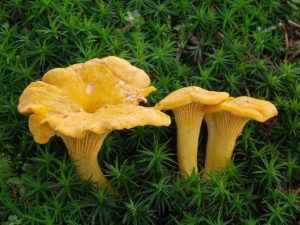
The chanterelles are a group of vase-shaped fungi with ridges or wrinkles, rather than gills, on their outer surface. As edibles, they range from good to excellent. Texas has several species, including the acclaimed Golden Chanterelle (Cantharellus cibarius), The Red Chanterelle (Cantharellus cinnabarinus), and The Texas chanterelle (Cantharellus texensis)—a recently-discovered species that may turn out to be unique to the state[iii].
Morels (Morchella sp.)
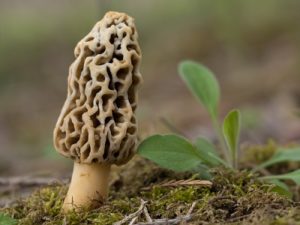
Morels are another group well-known as choice edibles. Their thimble-shaped, pitted caps are distinctive, so while it’s often difficult to determine which morel species a mushroom belongs to, it’s usually obvious that it is a morel. There are several other groups that include poisonous morel look-alikes, particularly the false morels and the early morels. Oddly, though, many people who eat these look-alikes don’t do so because of mistaken identity. Instead, some people can and do eat false morels safely (at least for a while). Meanwhile, true morels make some people sick. It’s not clear why these mushrooms are sometimes toxic and sometimes fine.
Texas is not a great region for morel-hunting, since they only appear in the northeastern parts of the state and do not fruit in years when there isn’t enough rain in the spring—but they are here. As to which species are here, the standard answer is yellows and blacks, which traditionally has meant M. esculentoides and M. elata, but morel taxonomy is in the process of change, and both these species are being split up. Since the process is still not finished, it’s hard to say what species are actually living in Texas[iv].
Oyster Mushrooms (Pleurotus sp.)

Oyster mushrooms are a group of mostly short-stemmed or fan-shaped wood-loving fungi. They have a soft, delicate texture and subtle flavor. In preliminary scientific studies, many have shown promise as possible sources of medicinal substances. Texas is a good state for hunting oysters, as many species appreciate the warm climate. The state’s oyster species include Pale Oyster (P. pulmonarius) and Pearl Oyster (P. ostreatus).
Puffballs
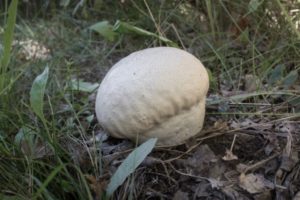
Puffballs are not a taxonomic group—that is, they are not especially related to each other, they just look alike[v]. They are all enclosed balls, sometimes on short stems, that contain developing spores within them. What counts as a puffball and what doesn’t varies to some extent depending on who’s counting.
The claim that all puffballs are edible requires defining the group in such a way as to exclude the poisonous species. Generally speaking, thin-skinned puffs with white interior flesh (until the spores start to mature and turn brown) are edible, and it is to them we refer here, but please research each species individually before you eat it. Please be aware, too, that a number of toxic species, including the aptly-named destroying angel, look very much like puffballs when young. It’s best to learn the difference. Texas species include several in the genera Lycoperdon and Calvatia, such as L. pyriform, L. perlatum, L. marginatum, L. curtisii, C. craniformis, and C. ruboflava.
White Jelly Fungus (Tremella fuciformis)

Yup, it looks like little globbies of white jelly. It’s also called snow fungus, and it’s a delicacy in China. This species is also thought to have some medicinal benefit, though the research is still preliminary. Reportedly, it doesn’t have much taste, but the texture is interestingly chewy. Culinary possibilities include mixing with egg to make omelets and lightly cooking and then soaking in fruit syrup to make a dessert[vi].
Stinkhorns
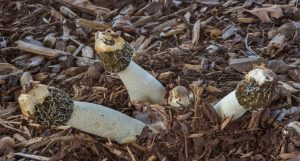
Stinkhorns are a group of mushrooms (related, but in multiple genera) known for their odd shapes and foul odor. They’re often listed, inaccurately, as inedible, simply because many writers can’t imagine wanting to eat one. In fact, many are known edibles, especially when they are young, before the foul odor develops. Some people really like them.
Texas has several species, including Mutinus elegans[vii], which at maturity is a long, red or reddish spike with a slime-covered tip, Lysurus periphragmoides[viii], which at maturity is a long, red column with what looks like a red and black, wrinkled ball on top, and Phallus hadriani[ix], which (as the name implies) does kind of look like a penis, at least while the smooth spore layer is still on the tip. Without that layer, it closely resembles an early morel. All three are reportedly edible in their early egglike stage (though beware that toxic Amanitas also have an egg stage). Even odder looking is Clathrus columnatus, which has two or more reddish arms that reach up and fuse together at the top, like some sort of mutant octopus. Whether it is edible is unclear.
Caesar’s Mushroom (Amanita caesarea)

Actually, the species attribution here might be wrong, though it comes from an otherwise respectable list of mushrooms found in Texas. Caesar’s mushroom is a European species (which is how the Caesars knew about it), and what grows in North America is a complex of closely-related and very similar species that mycologists have not entirely sorted out yet[x]. But Caesar’s mushroom is edible, and its American cousins may be as well. It’s also an Amanita, meaning that it has look-alikes that can kill you, so it’s not at all recommended for beginners. We’re including it here only because “edible Amanita” sounds like such a contradiction (like “giant shrimp” or “restless sleep”) that it’s fun to know it exists.
Psychedelic Magic Mushrooms in Texas
Yes, multiple species of “magic” mushrooms grow wild in Texas[xi]. No, it is not legal to use or possess them—within Austin prosecutors are now less likely to charge people for possession in small amounts, but they still have the option, and outside of the city a mushroom trip is still likely to lead to prison[xii]. A new state law does allow medical research on psilocybin[xiii], though, so there is some hope for decriminalization in the future.
Besides the legal danger and the (minor, but real) risks associated with psilocybin use itself, there is the risk of misidentification. Many psychoactive mushrooms are small, brownish, and non-descript, meaning they are easy to mix up with the Deadly Galerina—which has earned its name.
The following list is not exhaustive.
Psilocybe cubensis
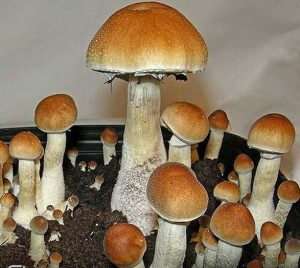
- cubensis is the most popular psychedelic mushroom currently, the one most often meant my the phrase “magic mushroom.” It’s commonly cultivated and exists in many varieties and strains, but is also grows wild in many places, and one of those places is Texas. In the wild, it usually feeds on and fruits from cow feces.
Panaeolus sp.

At least two psychoactive Panaeolus species grow in Texas. Both primarily deliver psilocybin, just like the Psilocybes do. P. cyanescens feeds on and fruits from cow dung and is generally more potent than Psilocybe cubensis. In contrast, P. subbalteatus may sometimes grow on horse dung, but is more often found fruiting from recently fertilized lawns[xiv]. It is known to be less potent than Psilocybe cubensis, sometimes substantially so, but easier to find.
Gymnopilus sp.
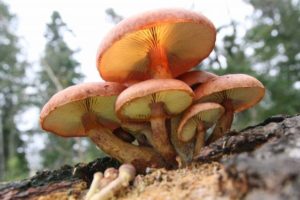
Texas has at least ten species of Gymnopilus that have at least some degree of psychoactivity: G. aeruginosus, G. junonius, G. luteofolius, G. luteoviridis, and G. sapineus. All are found in wooded areas. Although this genus does contain psilocybin, its high is distinctly different from that of the Psilocybes—sometimes described as less visual, but no less intense (depending on the dose). Potency varies from species to species.
Amanita muscaria
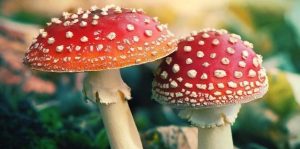
This one does not contain psilocybin. Many (not all) subspecies are psychoactive, but thanks to a very different active substance, so the high is very different—generally less visual, more mental, and leads to deep sleep. It’s important to note that Amanita muscaria also contains a toxin that must be deactivated through proper processing prior to ingestion or the trip will be most unpleasant and possibly dangerous. Also, this species is an Amanita, so it has deadly look-alikes.
Poisonous Mushrooms in Texas
Some toxic mushrooms can kill. Others merely sicken. Some are occasionally safe to eat, though a pleasant meal is no guarantee that you won’t get sick next time (especially considering that some mushroom toxins accumulate in the body). Please remember, too, that this is by no means an exhaustive list; the fact that a mushroom isn’t mentioned here should not be taken as evidence that it is safe to eat.
Destroying Angel (Amanita bisporigera)
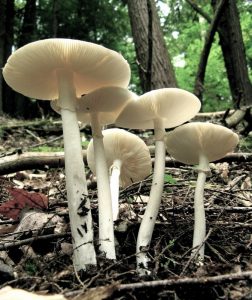
Destroying angel is, as the name implies, among the most poisonous species of mushroom in the world. It can kill adult humans, and has. It is part of the Amanita genus, a very distinctive group of mushrooms that also includes both edible and psychedelic members. While Amanitas aren’t really any more difficult to tell apart than any other mushroom group, the possibility of dying from a mistake leads many people to avoid Amanitas altogether.
Earthball (Scleroderma sp.)
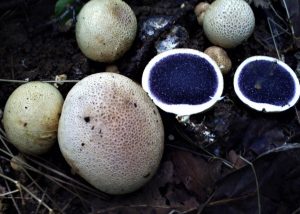
Earthballs are the puffballs’ evil twin—or, not evil, but certainly not edible. “Puffball” is just a term of convenience referring to any ball-shaped mushroom, so technically earthballs are puffballs, but since they are toxic and differ from the edible puffballs in certain respects (they are more firm, and their interior turns dark well before maturity), it makes sense to think of them as separate. S. texense, sometimes called tough puffball, is one species encountered in Texas.
Southern Jack O’Lantern (Omphalotus subilludens)
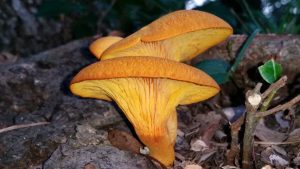
Jack o’lanterns get their name not so much for their pumpkin-like color but from the fact that they glow in the dark—the light is faint, only visible in complete darkness and sometimes not even then, though the glow is creepy enough when glimpsed in the woods at night. Jacks are toxic, and are sometimes mistaken for similarly-colored species of chanterelle.
False Parasol (Chlorophyllum molybdites)
Most people say that this one is the poisonous look-alike cousin of several well-known edible species of parasol mushroom. But there are also those who claim to have eaten the false parasol without ill-effect (at least when it is picked young and cooked well), and those who have gotten sick by eating one of the other parasols (especially if picked old and under-cooked). It may be fair to say that the entire group is risky to eat, with the false parasol being the riskiest and best left alone. In any case, false parasol differs from the other parasols in having green spores.

My name is Austin Collins.
I've dedicated my life to Mushrooms.
I believe Mushrooms are the best kept secret when it comes to health and well being.
For that reason, I would like to share a company with you that in my opinion makes the best mushroom products on the market.
The company is called Noomadic Herbals, my favorite supplement they make is called "Mushroom Total".
I take their products every day and they have helped me think better and have more energy. Give them a try.
-Austin
References:
[i] (n.d.). Texas Mushrooms. A. Sergeev
[ii] Simek, P. (2019). How to Find and Cook Texas Mushrooms. Texas Heritage
[iii] Kuo, M. (2015). Cantharellus cinnabarinus.
[iv] Kuo, M. (2012). The Morchellaceae: True Morels and Verpas.
[v] Kuo, M. (2008). Puffballs.
[vi] Volk, T. (2006). Tremella ficiformis, the Snow Fungus, and Edible Jelly Fungus. Tom’s Fungi
[vii] Roehl, T. (2017). #190: Common Mulch Stinkhorns. Fungus Fact Friday
[viii] (2018). The Stalked Lattice Stinkhorn. Suz and Tell
[ix] (n.d.). Phallus hadrani Vent.–Dune Stinkhorn. First Nature
[x] Kuo, M. (2013). Amanita jacksonii.
[xi] Stephenblevins (n.d.). Shroom Hunting in Houston, Texas. Shroomery
[xii] Chris Perri Law (n.d.). Magic Mushrooms and the Law: What You Need to Know. Do512
[xiii] Cutler, J. E. (2021). Texas the Latest State to Legalize Psychedelic Medical Research. Bloomberg Law
[xiv] (n.d.). Panaeolus cinctulus (Bolton) Brotzelm.


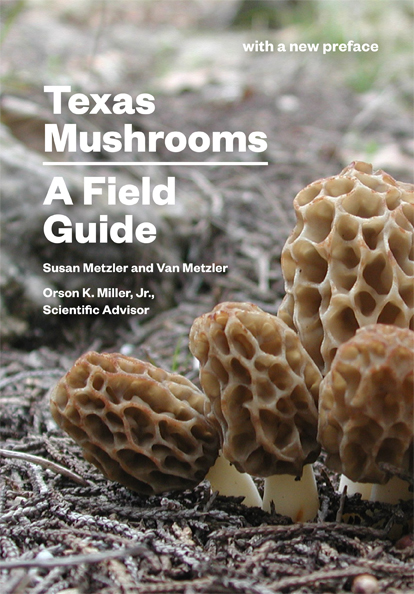
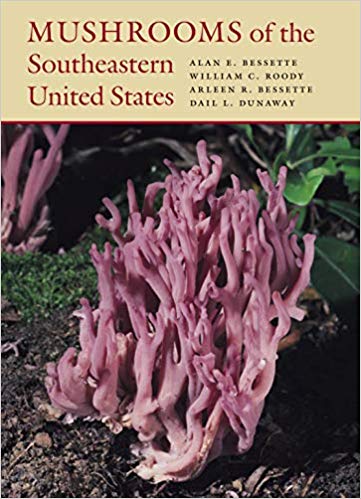


ok but can you give off more helpful info? i’m writing a journal on types of mushrooms, plants, and animals because i will soon move to a place that has open fields and a forest. so i need to identify these types of mushrooms. and well, for some of these you didn’t say what time of year they will grow, or if they were common to find or not, but this info that you gave off was helpful, thank you.
Buy one of the recommended field guides I listed if you want more in depth information. This is an introductory article. There is a reason entire books are written specific to an area.